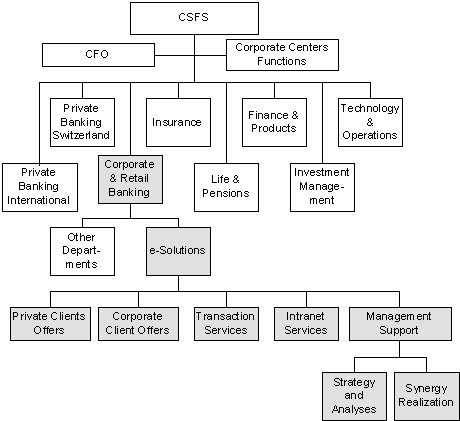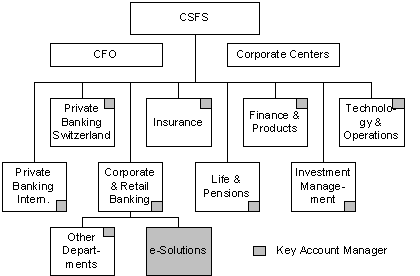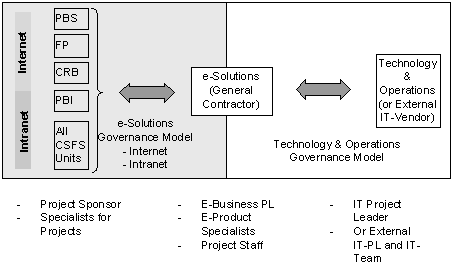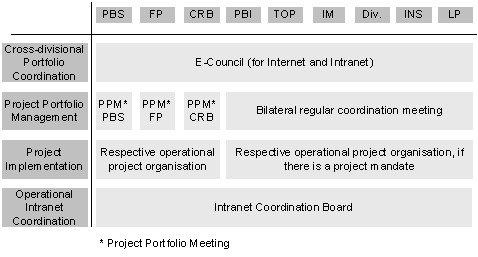e-Solutions of Credit Suisse
Credit Suisse is one of the world’s leading financial services providers. Credit Suisse is organised into the divisions of Credit Suisse Financial Services (CSFS) and Credit Suisse Boston. The E-Solutions department is the subject of this case study. E-Solutions is the centre of expertise within CSFS and looks after all the divisions’ E-Business needs.
1. The company
As one of the world’s leading financial services providers, Credit Suisse offers banking and insurance solutions for private and corporate customers. The company employs around 80,000 people worldwide. It is organised into two divisions:
- Credit Suisse Financial Services (CSFS) offers services in the field of private banking worldwide, looks after corporate and private customers all over Switzerland and comprises the two insurance divisions Life and Non-Life, which are positioned in the market under the name Winterthur Versicherungen.
- The business unit Credit Suisse First Boston (CSFB) operates in two markets: the Investment Banking division includes the loan and stocks business and the banking business. The CSFB Finance division comprises the asset management business, the securities processing business and the specific services for wealthy private customers in the USA.
The e-Solutions department of Credit Suisse was singled out for this case study. As a competence centre within CSFS, e-Solutions is responsible for meeting the needs of divisions in the E-Business segment. e-Solutions looks after the project portfolio with all the Web projects in line with the strategic positioning of the internet. e-Solutions has the task of using synerges and therefore increasing the efficiency and effectiveness of the utilisation of Web technologies [1].
none of the other new technologies which have emerged over the last few years
have had even a slight impact on the banking business.”
(Mario Crameri, Strategy and Analyses, Credit Suisse)
2. Organisation and competition
By the end of 2001, E-Business was hived off to form an independent business unit. The question of how to usefully accommodate the e-Solutions division in organisational terms came up during restructuring. CSFS decided to afford e-Solutions a central role by annexing it to the Corporate & Retail Banking department. Thus, the central E-Business unit was assigned to the business segment which serves the most customers (cf. Fig. 1). The department is now conceived as a cost centre.
The cost centre is mainly financed by the divisions. The budgeting process is organised as follows: the designated corporate centres of the divisions work out their division strategies in line with corporate strategy (CSFS strategy). The budgets for E-Business projects are also planned in the process. These e-budgets are managed by e-Solutions according to divisions. They must be renegotiated with the divisions each year. e-Solutions finances ongoing and new projects as well as the operation of Web technologies. In addition to the E-Business budget of the divisions, it also has access to funds for business initiatives.

Fig. 1: CSFS Organigram (simplified)
The Private Client Offers and Corporate Client Offers departments are responsible for the coordination and implementation of E-Business projects and for the operation and maintenance of existing services within the framework of core business transactions. The Intranet Services department, on the other hand, deals solely with employee IT support. The Transaction Services department provides joint E-Business solutions, such as, for example, online banking. Management Support defines the E-Business strategy together with the sales organisations and looks after the budgeting process, controlling of the project portfolio and the creation of synergies.
e-Solutions is responsible for the whole of CSFS as far as the intranet is concerned. All the other services it provides are only rendered for parts of the divisions: with respect to the three divisions of Private Banking Switzerland, Corporate & Retail Banking and Finance & Products, e-Solutions acts as a general contractor for internet use. Implementation is carried out either by the internal IT department (Technology & Operations) or external service providers.
Admittedly, e-Solutions has an internal monopoly with respect to all service purchasers, but the divisions still have a strong position, as they decide the e-budgets. Suppliers of e-Solutions are the Technology & Operation division (TOP) and external service providers. As e-Solutions can fall back on external service providers in exceptional circumstances, the market dominance of the TOP division is quite small.
Potential new competitors and substitutes only represent an average threat to the position of the e-Solutions department. Despite internal guidelines, the divisions may have their solutions implemented directly by TOP or even by external providers in individual cases.
3. Handling of new technologies
From 1996 to 2001, Credit Suisse was one of the first movers, for example, in the field of online banking or wap trading. During this period a determined team concentrated on investigating and developing new technologies on the business side. In 2002, the situation changed. e-Solutions recognised and implemented a lot of new technologies, but the impact on business as a result of this was all too rare.
Expectations have consequently become more modest. Nevertheless, the attitude of the management and employees towards new technologies is very open-minded. Overall it is agreed that information and communication technologies are a success factor. Investments are, however, being made more selectively in comparison to the previous five years.
4. Status and vision of E-Business
The current vision for internet use is no longer as euphoric as in 2000, when the talk was of a “brave new internet world”. The main goal for E-Business use now lies in supporting the divisions. The main focus is on end users. They are specifically offered all communication media (e-mail, telephone, SMS, Web, branches, etc.)
Retail customers use the internet as an instrument to carry out standard transactions. The retail customer becomes a self-service customer. The goal is a multi-channel platform which allows customers to access their data with any end device of their choice. On the other hand, in the Private Banking department the internet is primarily used to support sales consultants.
Employees are supported both by the intranet and by a CRM solution. The CRM tool is used as an instrument for the purposes of differentiation from competitors. It offers an insight into activities and data of customers at a glance. Processes are to be optimised by means of an employee portal offering information which is matched to specific roles and needs.
An extranet solution has been implemented to link up agents, brokers and external asset managers.
Overall, the goal in the next few years will be to consolidate existing Web technologies. The consolidation will lead to the integration of internet platforms amongst each other following the construction of new channels as individual solutions over the last few years.
5. Organisation of E-Business
Structure: The e-Solutions department sees itself as a nerve centre between users and IT. It supports the divisions when formulating needs. Contact persons are available in each division (Key Account Managers). The central e-Solutions department forms the E-Business organisation of CSFS together with the decentrally organised Key Account Manager (cf. Fig. 2).
Orientation: Officially e-Solutions orientates itself towards two performance targets:
- CSFS corporate strategy: basic principles, guidelines for CSFS as a whole
- Strategic business plans of the divisions
e-Solutions is answerable to two sources. In actual fact the influence of division strategies is greater, as e-Solutions cooperates directly with the divisions. Planning for division activities is carried out in the respective corporate centres.
The Strategy & Analyses department of e-Solutions works out the E-Business strategy for CSFS on the basis of the two strategic targets. This is a functional strategy which is mandatory for all divisions within the context of its respective divisional strategy.

Fig. 2: E-Business organisation of CSFS.
Coordination: e-Solutions acts as a coordinator between the service procurers (divisions) and the service providers (TOP and external providers). The department defines and formulates individual needs together with the divisions. It forwards these to TOP, where technical practicability is examined.
e-Solutions tries to match business requirements with the potential of IT as closely as possible, so that the solutions are essentially business-oriented rather than IT-oriented.
This cooperation is emphasised in the governance model of e-Solutions (cf. Fig. 3). The aim is to implement synergies and avoid redundancies, to use know-how efficiently and to coordinate communication with bank customers.
Coordination mechanisms are established on four levels: the E-Council is responsible for the intradivisional coordination of the project portfolio. The E-Council is responsible for internet and intranet E-Strategy, for resource allocation and the prioritisation of projects. These tasks are carried out by the head of e-Solutions and the delegated persons in the respective divisions. [Governance Model]

Fig. 3: Governance model of CSFS.
Individual project portfolio meetings are held for the Private Banking Switzerland, Finance & Products and Corporate & Retail Banking divisions, in order to assess the status quo of the current project portfolio and to determine the future budget. This function is carried out by the head of e-Solutions, the head of the corporate centre of the respective division, the department manager and the IT manager.
The project portfolio management for the other divisions is carried out as required within the framework of bilateral coordination meetings. The aim in this case is to identify and implement synergies between the divisions and to formulate e-standards. The head of e-Solutions, the head of the corporate centre, the persons in charge from the divisions and representatives from e-Solutions carry out this function.
Project implementation is carried out according to operational project organisation [coordination mechanisms]

Fig. 4: Coordination mechanisms of e-Solutions.
The Intranet Coordination Board is responsible for coordinating intranet projects at operational level. It meets approximately five times a year and reviews the potential for improving the intranet. Members are the head of intranet services at e-Solutions, persons in charge of the intranet from various divisions and e-Solutions representatives.
6. Challenges in E-Business
The main challenge lies in stipulating investment priorities in new technologies. All kinds of factors decide whether or not a technology catches on:
- the efficiency of the technology
- customer acceptance
- the internal and external incentives
- the cost-benefit ratio for the bank
The investments required to develop and launch new technologies are so considerable that it is not economical to pursue all trends. A good model for prioritisation is essential.
The danger of new competitors seems to have been averted at present. Traditional financial services providers have been able to ward off new competitors, such as telecommunications providers, by reacting quickly and becoming “e-able” themselves. The entry barriers have not been reduced by the internet and have instead tended to increase, as large investments are required for E-Business projects.
External challenges have been replaced by internal challenges: up until 2001, the mission of the E-Business department was to sensitise the divisions to the subject of the internet. Now the aim is to arouse the divisions willingness to pay for consolidation. Although the project actually works, it makes sense now to invest in the integration of Web technologies to increase efficiency.
At present, CSFS thinks that the operation of a central service department makes good economic sense, in order to be able to gain maximum benefit from the internet and other new technologies. This central department will be needed for as long as the definition of needs on the part of users and the description of the capabilities of IT on the part of providers need to be imparted, coordinated and advised. Once the know-how and experience is established in all departments, it is possible that e-Solutions can be integrated into the divisions in a totally decentralised fashion.
7. Conclusion
Killer applications are developments which revolutionise an industry from its roots upwards, although not every technological innovation is a killer application. A distinction must be made between sustaining and disruptive technologies. Developments in the field of sustaining technologies especially refer to an improvement in the performance of established products and seldom bring about pioneering changes. Disruptive technologies on the other hand involve consequences for the entire industry: they redefine the starting situation for all market participants and become a dominating customer need at a point in time which is not definable in advance. This is what is called a killer application. In the financial services industry internet banking has turned out to be a killer application.
The e-Solutions department of Credit Suisse sees itself as being confronted by constant pressure from new technologies. The difficulty now lies in identifying other possible killer applications, i.e. distinguishing between sustaining and distruptive technologies and to set investment priorities accordingly. The aim is to recognise the signs of killer applications which are about to break, in order to avoid being caught on the hop by new customer needs. Nevertheless, it is not possible to pursue and implement all new technologies with a high intensity for financial reasons.
If a killer application is identified, it is important to bear in mind that market demand often grows at a slower rate than technological possibilities.
The e-Solutions department operates in this tense environment between technology push and market pull in its role as a mediator between the IT department and the divisions. The organisational structure with central and decentralised units is ideally suited to coping with this tense environment. The speed of change in the technology markets has slowed down considerably over the last two years, so that Credit Suisse has already got rid of parts of its central E-Business organisation. If it were possible to foresee even more clearly which sustaining and which disruptive technologies were relevant to Credit Suisse in the near future, a higher degree of decentralisation would make sense.
![]()
[1] This case study is based on an interview which took place on 24 June 2002 at Credit Suisse. The interviewees were Mario Crameri and Daniel Hunziker. Their responsibilities in the Strategy and Analyses department of the e-Solutions division include E-Business strategy.



